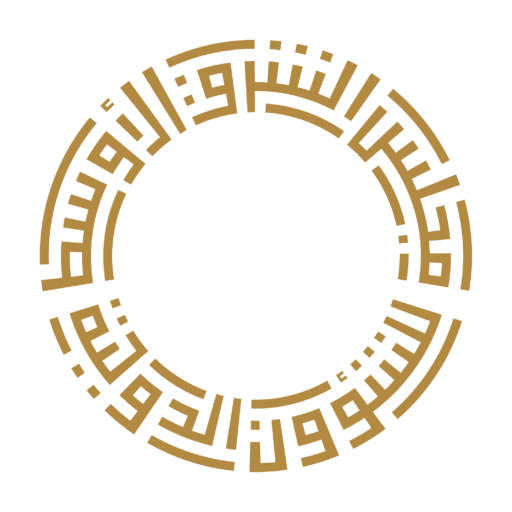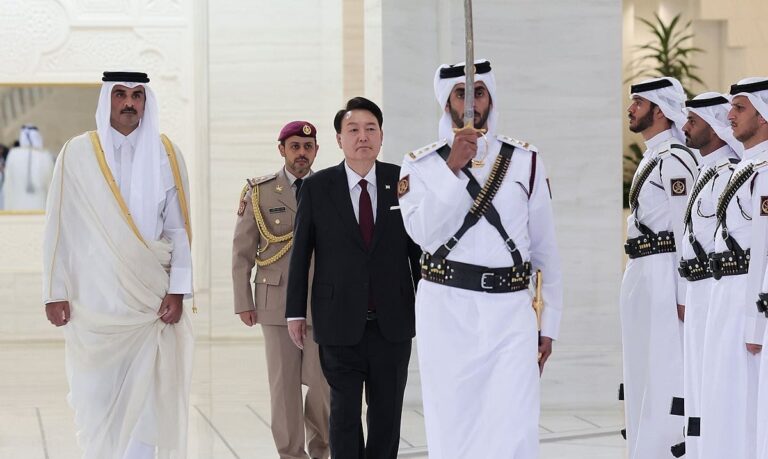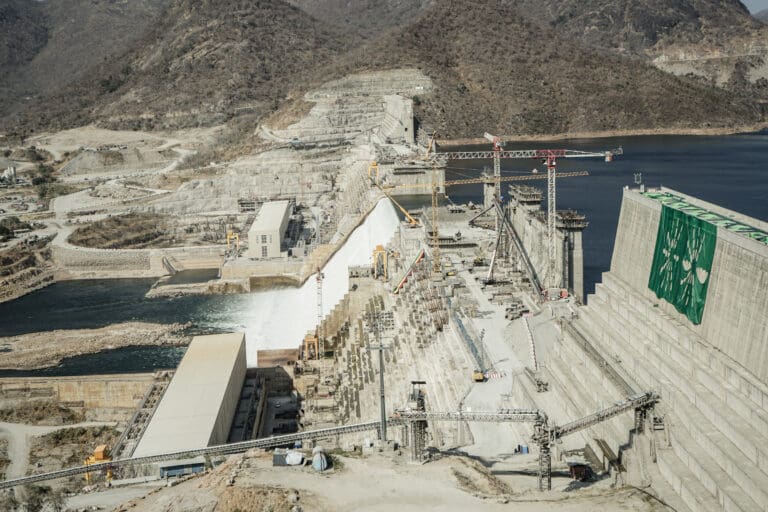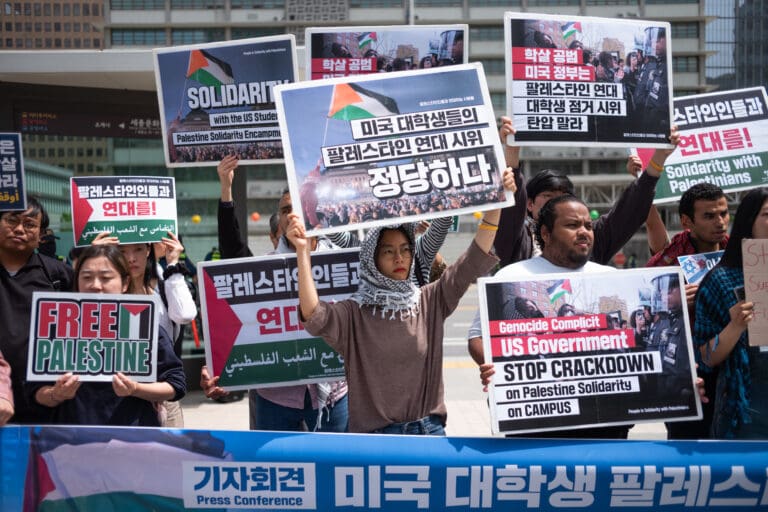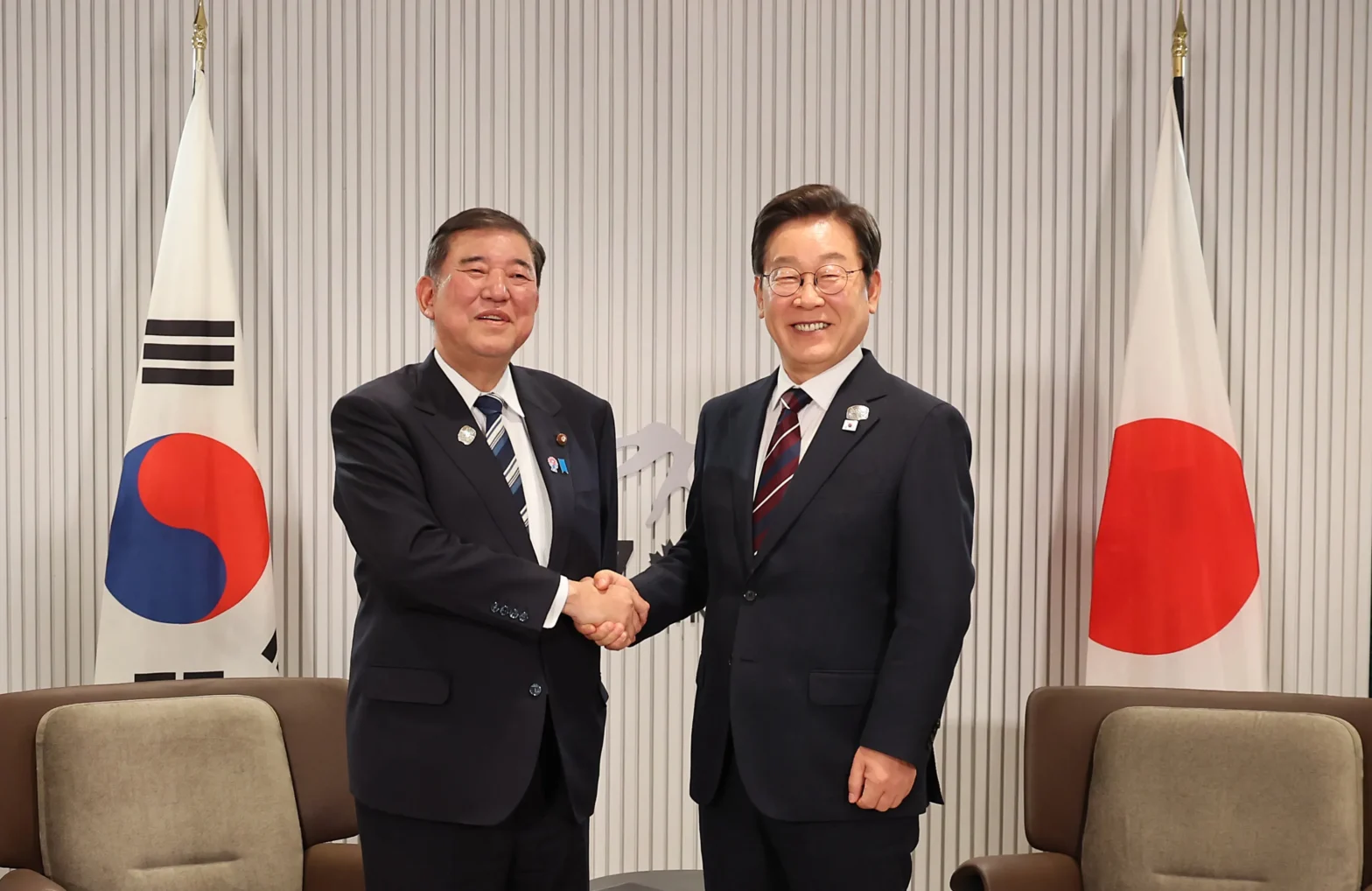
Beyond Competition:
Japan, South Korea and the Imperative for Cooperation in the Middle East
Policy Paper, August 2025
Abstract
This policy paper examines the complex dynamics of competition and cooperation between Japan and South Korea in the Middle East, highlighting how geopolitical shifts, economic imperatives, and domestic politics shape both rivalry and opportunities for cooperation. As the two most influential East Asian middle powers, Japan and the Republic of Korea (ROK) are deeply invested in the Middle East’s strategic importance for energy security, trade, and regional stability. Despite inevitable competition—particularly in infrastructure, nuclear technology, and defense industries—the paper identifies significant areas for collaboration, driven by shared interests in securing maritime routes, promoting regional stability, and navigating the global energy transition. Geopolitical turbulence, including conflicts in Gaza, tensions in the Red Sea, and great power rivalries involving China, Russia, and the United States, further underscore the urgency for coordinated engagement. Ultimately, this policy paper contends that balancing competitive dynamics with selective collaboration offers Japan and South Korea a strategic pathway to amplify their roles as responsible middle powers.
Key Recommendations
Enhance Maritime Security Cooperation and Peacebuilding: Japan and South Korea can deepen security cooperation in the Middle East to mitigate threats to maritime routes critical for their energy imports and global trade. Joint naval patrols, intelligence-sharing, and coordinated operations would improve their capacity to protect shipping lanes in the Red Sea, Gulf of Aden, and Strait of Hormuz.
Support and Coordination for Peacebuilding Efforts in the Middle East: Japan and South Korea should collaborate to support the reconstruction of Gaza. Jointly leveraging initiatives such as the Conference on Cooperation among East Asian Countries for Palestinian Development (CEAPAD) and expanding development assistance allocations to the Middle East can amplify Japan and South Korea’s diplomatic influence and maximize the effective allocation of humanitarian and development aid.
Advance Joint Energy Security and Clean Transition Partnerships:
Amid rising geopolitical risks and the global energy transition, Japan and South Korea should develop joint mechanisms to protect critical Middle Eastern energy infrastructure from physical and cyber threats. Both nations should pursue collaborative investments in renewable energy projects across the MENA, contributing to regional economic diversification and climate goals. Establishing a formal GCC–Japan–ROK energy transition dialogue could facilitate coordinated policymaking, technology sharing, and private sector investments.
Foster Politically Neutral, Economic Focused Cooperation: Civilian-led diplomacy and multilateral engagement platforms can sustain dialogue and partnerships between Japan and South Korea amid shifting strategic priorities and the intensifying pressures of great power competition on both East Asia and the Middle East. By focusing on pragmatic economic cooperation and mutually beneficial industrial ties in the Middle East, both countries can protect their long-term interests and maintain constructive roles in the region. Japan’s Free and Open Indo-Pacific (FOIP) strategy provides a useful framework to extend shared principles of stability, rule of law, and secure maritime commerce into their Middle East policies.
Introduction
The international system is undergoing fundamental changes unlike anything seen since the end of the Cold War. The second Trump administration, the erosion of international law amid the Ukraine and Gaza wars, and growing great power competition all indicate a shifting regional and global order.
The rise of middle powers is also reshaping the international system in significant ways.1 These states, defined by their regional influence and global aspirations, occupy a unique position between great powers and smaller powers. Their growing economic clout, diplomatic engagement, and military/defense capabilities have given them opportunities to support global order and international norms. Japan and the Republic of Korea (ROK), the two major East Asian middle powers, have increasingly turned their attention to the Middle East, driven by energy security needs, economic interests, and broader geopolitical and geoeconomic considerations.
This policy paper examines the dynamics of competition and cooperation between Japan and ROK in the Middle East. Both countries often find themselves competing for energy deals, infrastructure contracts, export markets and geopolitical influence. Factors such as history, domestic politics, economic considerations, and external pressures from global powers like the United States and China further shape the interplay between cooperation and competition.
Despite their rivalry and multiple barriers to cooperation, this policy paper argues that there is room for both countries to cooperate on issues where their interests converge, in areas such as regional stability and security, geopolitical alignment, regional peacebuilding, and energy security and transition initiatives. While cooperation between these two occasional rivals entails challenges, the paper argues that coordination can bring benefits to both Tokyo and Seoul, as well as the Middle East and the world.
Inevitable Competition?
Given the developmental and political trajectories of Japan and the ROK, along with their complicated histories, some competition is inevitable, both globally and in the Middle East. As a key supplier of energy to both countries, the Middle East is a crucial market where Japanese and Korean products and services are in direct competition over market share and access. Japan developed its manufacturing base earlier than South Korea, and thus Japanese companies long benefited from exporting high-end electronics, automobiles, and industrial machinery to the region. From the 1970s onwards, Middle Eastern countries showed a growing demand for Japanese products which historically had a reputation for quality and precision.
After the 1973 oil crisis, Japanese companies began participating in local mega-infrastructure projects as well as oil development. Initially, they participated in engineering, procurement, and construction (EPC) contracts for power plants and other facilities. Then in the 2000s, they began operating as independent power producers (IPPs), not only holding shares in facilities alongside local government-affiliated companies, but also operating and maintaining them. Today, Japanese companies account for a large share of the Gulf Cooperation Council (GCC)’s power generation capacity.
The 2000s also saw a rush of Japanese construction companies entering the Middle East, as the demand for infrastructure grew along with the region’s economies. For example, the tender for the Dubai Metro was awarded to the Dubai Rail Link (DURL) consortium made up of Japanese companies including Mitsubishi Heavy Industries, Mitsubishi Corporation among others. Despite changes in specifications and the 2008 global financial crisis, the project—the Middle East’s first fully automated driverless urban transit system—was completed on time in September 2009, further burnishing Japan’s image.2
Japan’s involvement in the infrastructure and industrial sectors across the Middle East and North Africa demonstrated its strategic commitment to economic development, evidenced by projects such as the Abu Dhabi Urban Master Plan, the Cairo Opera House in Egypt, the Petro Rabigh Petrochemical Project in Saudi Arabia, the Automotive Wiring Harness Manufacturing Plant in Morocco, and the active participation of major Japanese financial institutions in MENA markets. However, Japanese firms recently faced an uphill battle to win similar projects, as Korean and Chinese firms entered the market, intensely competing on cost.
As South Korea developed its economy and expanded its manufacturing base, it was able to catch up with Japanese firms in the Middle East. Today, Korean conglomerates such as Samsung, Hyundai, LG, and Daewoo operate widely across the region, with significant market share in their respective industries. In addition, ROK expanded cooperation to nuclear technology, and has also entered various new sectors. These include solar, hydrogen, and wind power, eco-friendly smart cities and digitalization, cutting-edge manufacturing, medical care, and the tourism sector. Moreover, South Korea and the GCC signed a free trade agreement in December 2023, under which the former will eliminate tariffs on about 90% of all items while the latter will remove them on over 75% of traded items .3 While the agreement was signed in 2023, it has yet to go into effect.
From the 1970s onwards, South Korean companies were able to secure a foothold in GCC economies by significantly undercutting the competition on price and displaying an openness to compromise on profit margins to secure contracts.4 They continue to hold a comparative advantage in securing construction contracts in the region. From 2002 to 2020, for example, the Middle East accounted for over 50% of the total value of Korean conglomerates’ overseas contracts: $444 billion out of a total of $845 billion.5 In addition to the Burj Khalifa, the world’s tallest building, ROK has also supported mega-projects such as the Sheikh Jaber Al-Ahmad Al-Sabah Causeway in Kuwait City6 and a small nuclear reactor for desalination in Saudi Arabia.7
Figure 1: Top 10 MENA Trade Partners of South Korea (2010-2024)8
Figure 2: Top 10 MENA Trade Partners of Japan (2010-2022)9
When it comes to nuclear energy, South Korea has outbid Japan on tenders to build nuclear plants, fueling an uneasy rivalry between the two. In 2009, South Korea signed a contract with the UAE to build Barakah Nuclear Power Plant Units 1-4, the country’s first nuclear plant. It defeated rival bids from a Japan–U.S. consortium that included Japan’s Hitachi, Toshiba, and the U.S.’ General Electric. Despite Japan’s established nuclear expertise and international reputation, its bid was seen as less competitive in terms of cost, safety, and delivery timeline.10 In September 2024, the UAE announced the commencement of commercial operations at the Barakah Nuclear Power Plant’s Unit 4, highlighting the Korean-built facility’s key role in the country’s decarbonization efforts. In Saudi Arabia, South Korea has already secured a crucial position in the race for its nuclear reactor program contract, with bidding scheduled to begin in late 2025.11
South Korea is on a drive to revitalize its nuclear industry, setting the export of 10 nuclear reactors by 2030 as a key national priority. To achieve this goal, it has strengthened the “Team Korea” consortium which includes Korea Electric Power Corporation (KEPCO), Korea Hydro & Nuclear Power (KHNP), financial institutions, and private companies. Furthermore, in January 2025, South Korea and the United States signed a nuclear export cooperation agreement to enter the global nuclear power market together as “Team KORUS.” This collaboration is expected to accelerate South Korea’s expansion into the Middle East’s nuclear power markets. Under this partnership, South Korea is expected to take the lead in the Middle East while the United States leads in the European market, in a strategic division of roles.
Figure 3: South Korea and Japan’s Exports to the GCC (2010-2022)12
Japan also shares robust economic relations with the GCC. In 2023, Japan ranked as the GCC’s fourth-largest trade partner, with Gulf imports from Japan reaching about $22 billion.13 The GCC automobile market has long been dominated by Japanese cars; taken as a unit, the region is the second-largest customer for Japan’s auto exports.14 The GCC’s construction and oil industries also import numerous machines from leading Japanese machinery firms.
Within defense, Korea remains well ahead of Japan. South Korea is aiming to solidify its position in the Middle East, which receives a considerable share of its defense exports.15 From 2013 to 2022, South Korean arms exports to the region increased nearly tenfold.16 ROK has recently emerged as the world’s ninth-largest arms exporter, and has announced plans to rise to fourth place by 2027.17
South Korea’s remarkable rise in the defense industry is driven by four factors: the global surge in arms demand due to the war in Ukraine, the cost-effectiveness and high performance of South Korean weaponry, rapid delivery capabilities, and the South Korean government’s push for the commercialization of the “K-Defense” strategy. This refers to South Korea’s integrated defense initiative aimed at expanding arms exports—centered on advanced indigenous systems like the K9 howitzer, FA-50 fighter jet, K2 tank, and Cheongung-II surface-to-air missile system—to strategic markets such as the Middle East and Europe, while simultaneously fostering the defense industry as a national growth engine and extending the country’s influence through security cooperation and defense diplomacy.
Notably, South Korea has expanded its exports of key defense products, such as the Cheongung-II, K9 self-propelled howitzer, and the K2 main battle tank, by integrating them into the training programs of purchasing countries in the Middle East. This approach facilitates both technology transfer and capacity building, further evolving into industrial cooperation pilot projects, aligning with the objectives of the Gulf countries seeking to strengthen their domestic defense capabilities. With the signing of the Korea-GCC FTA and the Korea-UAE Comprehensive Economic Partnership Agreement (CEPA) in 2024, tariffs on most of South Korea’s key arms exports to the GCC countries have been eliminated. This is expected to further accelerate the growth of weapons sales to the Gulf.
By contrast, Japan’s arms sales to the region have been limited by the country’s constitutional and legal restrictions. Namely, the “Three Principles on Arms Exports”18 which prohibit weapons sales to communist countries, states under UN arms embargoes, and countries involved in or likely to provoke international conflicts.
Although the second Abe administration eased restrictions in 2014 by partially revising these principles, concerns over reputational risks associated with involvement in regional conflicts, combined with intense competition from established arms exporters such as the United States, United Kingdom, and France, challenge Japanese defense exports to the GCC. That said, Japan and Oman held their first military-to-military dialogue in Muscat in June 2023, with a focus on enhancing naval cooperation. This was followed by a second meeting in Tokyo in May 2025.19 Qatar and Japan also held their first military-to-military dialogue in 2023.20 That same year, Japan and the UAE signed an agreement on the transfer of defense equipment and technology. This agreement established a legal framework for joint research, development, and production of defense equipment and technology, and is Japan’s first such agreement with a country in the region.21
Complicated History and Politics
In addition to their economic rivalry, cooperation between Japan and South Korea has also arguably been hampered by their complicated shared history and respective domestic politics.22 Despite these issues, the Kishida (2021-2024) and Yoon (2022-2025) administrations oversaw a considerable thaw between Japan and ROK, facilitated by the United States under the Biden administration. The 2023 summit between Kishida and Yoon marked the first meeting between Japan and ROK in 12 years, and was focused on addressing the shared threat posed by North Korea and growing concerns over China.23 However, Yoon’s declaration of martial law and subsequent impeachment, followed by early presidential elections in June 2025, reflected a major political transition.
With the election of progressive party candidate Lee Jae-myung as president, South Korea’s foreign policy is expected to shift, potentially leading to a reduced emphasis on the Middle East as a strategic priority and a more restrained approach to cooperation with Japan. South Korea’s progressive parties have traditionally favored engagement with North Korea but a more critical stance toward Japan, shaped by tensions over its colonial past. They have also often prioritized regional diplomacy centered on the Korean Peninsula. The party’s foreign policy is therefore largely regionally focused, emphasizing ties with China, Russia, and Southeast Asia, while showing relatively little engagement with more distant regions like the Middle East.
Under Moon Jae-in’s progressive administration, a domestic nuclear phase-out lowered the credibility of South Korea’s nuclear power plant construction efforts in the UAE. The Moon administration halted nuclear power plant projects mid-construction which led to many nuclear engineers leaving for foreign countries including China. Korea-Japan relations also reached a low point as anti-Japan sentiment, fanned by the Moon administration, was met with a firm conservative response from Japanese Prime Minister Abe.
In June 2025, following his election, President Lee declared that he would pursue a foreign policy based on pragmatic, market-oriented principles. The United States has already underscored the need to contain China and deepen trilateral cooperation with South Korea and Japan. Meanwhile, China and Russia have expressed hopes for improved relations with South Korea’s new president, while Japan has been reserved.
Domestically, ROK’s greatest concern lies in the security threats posed by North Korea’s nuclear program and growing ties between North Korea, China, and Russia.24 President Lee’s stance on nuclear energy appears to have shifted from the previous phase-out policy toward a more pragmatic approach of gradual reduction. He has expressed support for the research and development of next-generation nuclear technologies such as small modular reactors (SMRs). This is viewed as a practical response that balances realistic energy demands with South Korea’s carbon neutrality goals.25
Japan’s Prime Minister Shigeru Ishiba, who took office in October 2024, has pledged to uphold the diplomatic framework of the Kishida administration, which prioritized strengthening ties with the United States and partner countries. In light of escalating security challenges, including China’s assertive actions and North Korea’s nuclear and missile developments, Ishiba aims to enhance the deterrence and response capabilities of the U.S.-Japan alliance. Building a strong working relationship with President Donald Trump and key figures in his administration will be an immediate diplomatic priority. Ishiba’s first overseas trip in October 2024 was to participate in a number of ASEAN related engagements including the 27th ASEAN Japan Summit, underscoring the importance of deepening political, economic, and security ties with Southeast Asian nations.26
However, Ishiba leads a minority government, the first in 30 years, making his administration politically fragile and requiring careful coordination with other parties to advance key policy initiatives. Amid rising tensions in East Asia, bolstering Japan’s defense capabilities and securing the necessary fiscal resources for such efforts have emerged as urgent priorities. Under these political and security pressures, Japan’s engagement in the Middle East may become a lower priority, potentially reducing its regional presence. This shift raises concerns about diminished momentum for Japan-ROK cooperation in the region, which could weaken broader collaborative efforts on security and economic stability.
Toward Common Ground
Despite their economic rivalry along with historic and political complexities, there are areas where Japan and South Korea’s interests are aligned. Given the increasingly complicated global geopolitical picture, it is in the interest of both countries to find avenues for cooperation in the Middle East. These include the following:
1. Maritime Security and Peacebuilding
The October 7 attacks in 2023 and Israel’s subsequent large-scale military operation in Gaza, as well as the 2025 Iran-Israel war, have significantly destabilized the Middle East. Regional conflicts and tensions have created additional risks for Japan and ROK as they seek to expand their engagement in the region. Incidents such as attacks on and the seizure of Japanese vessels in the Red Sea by Yemen’s Houthis underscore the dangers.
Piracy in key maritime chokepoints like the Gulf of Aden and the Strait of Hormuz poses significant risks to Japan and ROK, as well as to global shipping and energy security more broadly. This heightens the need for enhanced Japan-ROK cooperation. Japan’s Self-Defense Forces (SDF), with over a decade of experience in maritime security operations in the Gulf of Aden, could collaborate more closely with the South Korean Navy through joint patrols and exercises, helping secure oil tanker routes and deterring piracy. Japan’s SDF facility in Djibouti could serve as a strategic hub for joint operations, intelligence sharing, and humanitarian missions, particularly given Japan’s plans to expand its mandate for overseas operations.27 This would provide new opportunities for Japan-ROK military cooperation in securing vital sea lanes between the Middle East and East Asia.
South Korea and Japan’s participation in the U.S.-led International Maritime Security Construct (IMSC) to safeguard freedom of navigation is another effort aimed at countering the disruption of energy security and supply chains. When the United States asked ROK to join IMSC in 2020, Seoul chose to operate its naval unit independently, opting to cooperate with the coalition upon necessity. Two South Korean liaison officers were dispatched to the IMSC.28
Japan, which plays a strong role in maritime security in the Red Sea, through international cooperation, has previous experience deploying the Maritime SDF (MSDF) to combat piracy in the Gulf of Aden, near Somalia. If instability in the Red Sea worsens, Japan could consider expanding the role of the MSDF or dispatching additional troops. Japan will likely cooperate within the framework of the Japan-U.S. alliance, provided that the U.S. request does not conflict with constitutional restrictions or domestic political controversies. In April 2024, the maritime forces of the United States, ROK, and Japan conducted a trilateral maritime exercise, reaffirming their commitment to bolstering regional security and stability in the Indo-Pacific.29 Such operations could also pave the way for expanded cooperation in Middle Eastern maritime security, particularly as the alliance between China, Russia, Iran, and North Korea strengthens.
2. Support and Coordination for Palestinian-Israeli Peacebuilding
The resolution of the Israeli/Palestinian conflict remains vital to the stability and security of the Middle East. Japan and South Korea could therefore coordinate to support the resolution of the long-standing conflict. At the humanitarian level, both countries historically supported the Palestinians via aid. Since 1993, Japan transferred $2.3 billion to support the Palestinian Authority.30 Over the decades, Japan has also supported the Palestinians’ right to self-determination. South Korea has also supported the Palestinians over the decades. Both countries are thus poised to support Gaza’s reconstruction.
Although South Korea has increased aid and humanitarian support to the Middle East over the years, its contribution to the region remains limited. In 2024, South Korea’s official development assistance (ODA) amounted to approximately 0.21% of its Gross National Income (GNI), falling short of the OECD Development Assistance Committee (DAC) average of 0.33%.31
Moreover, due to geographic proximity and historical ties, South Korea’s ODA has largely focused on Southeast Asian countries, while its support to the Middle East has mostly taken the form of emergency humanitarian relief. While South Korea benefits from the Middle East’s defense and nuclear power markets, its aid and financial contributions to Palestine are limited. Supporting Gaza’s reconstruction and peace-building efforts presents a crucial opportunity for ROK to bolster its role in supporting global and regional humanitarian efforts.
The decision by both countries in April 2024 to support the recognition of Palestine at the UN was a landmark step and arguably added further pressure on Israel to de-escalate. Supporting a durable solution to the Palestinian issue is therefore aligned with the values and interests of both Japan and South Korea.32 Building mechanisms for cooperation on reconstruction and humanitarian aid, possibly with European and other development and finance actors, will become more critical as the U.S. Agency for International Development (USAID) suspends most of its programs including the ones in the Middle East under the second Trump Administration. The Conference on Cooperation among East Asian Countries for Palestinian Development (CEAPAD), initiated by Japan in February 2013, could be a platform for enhancing collaborative support for humanitarian assistance and recovery and reconstruction efforts in Palestine.33
3.Geopolitical Alignment
Strategic cooperation between ROK and Japan will deepen in parallel as ties between North Korea, Russia, China, and Iran deepen. The United States is increasingly pushing its allies to expand their contributions to countering China’s growing influence in the Indo-Pacific. In 2023, ROK, the United States, and Japan held a joint summit at Camp David, seeking ways of responding to renewed great power competition and the nuclear and missile threat from North Korea.
ROK and Japan could extend this alignment to advancing cooperation in the Middle East. In addition to foreign ministries, development agencies such as the Korea International Cooperation Agency (KOICA) and Japan International Cooperation Agency (JICA), trade agencies including the Korea Trade-Investment Promotion Agency (KOTRA) and Japan External Trade Organization (JETRO) could meet routinely to explore opportunities for cooperation in development and business.
Japan’s vision for a Free and Open Indo-Pacific (FOIP) can serve as a cornerstone mechanism for multilateral cooperation, functioning as a geo-strategy that combines economic, diplomatic, and security elements. From the standpoint of ensuring the security of sea lanes and energy in the Indo-Pacific, there is an opportunity for Japan, ROK and other countries to engage cooperatively in the Middle East, particularly given the volatile international political landscape under the second Trump Administration.
4.Collaborative Energy Security and Transition Initiatives
During Prime Minister Kishida’s visit to Saudi Arabia, the UAE, and Qatar in July 2023, discussions focused on advancing collaborative efforts in decarbonization technologies and the production of hydrogen and ammonia, positioning the Middle East as a future global hub for clean energy and critical minerals. This strategic pivot toward economic and technological collaboration on the energy transition leverages Japan’s strengths and aligns with global energy transition goals. It also provides a pragmatic way to ensure a stable supply of oil and natural gas for Asia during the protracted transition to a low-carbon future.
To strengthen energy security and transition efforts, Japan and ROK could collaborate on protecting critical energy infrastructure by forming joint task forces to monitor and respond to threats to regional energy facilities. Japan’s Ministry of Economy, Trade and Industry (METI), the Agency for Natural Resources and Energy, and the Japan Organization for Metals and Energy Security (JOGMEC) could partner with their South Korean counterparts in this endeavor. Given rising geopolitical risks, Seoul and Tokyo could establish a joint response mechanism to monitor and protect critical infrastructure such as LNG terminals and power grids against physical and cyber threats, through enhanced intelligence sharing between relevant agencies.
Additionally, the two countries could jointly invest in renewable energy projects in the region, focusing on solar, wind, and hydrogen initiatives in GCC and North African countries, while encouraging private investments. A trilateral dialogue on energy security and transition involving the GCC, ROK, and Japan could serve as a starting point for formal cooperation. These investments and initiatives would contribute to regional economic stability by addressing underlying causes of instability, thereby enhancing overall security in the region.
Japan has been encouraging South Korea’s participation in the Asia Zero Emission Community (AZEC) as an important step for cooperation on the energy transition. Under the Yoon administration, South Korea has been strengthening its cooperation with Japan on energy transition, particularly by advancing joint projects in areas such as ammonia co-firing, hydrogen, and carbon capture and storage (CCS) technologies.
5. Win-Win Cooperation Grounded in Political Neutrality
The Middle East policy of the newly elected South Korean government is likely to maintain business-centered cooperation, while scaling back strategic partnerships. President Lee may be expected to advocate pragmatic, national interest–oriented diplomacy, which suggests that major export projects such as K-defense and K-nuclear technology may continue. However, it is likely to reconsider its strategic security cooperation with the Middle East.
Cooperation with Japan is also likely to be reduced, with a weakening of top-level engagement, although some public-private collaboration may persist. In light of this strategic realignment, a new response strategy is needed to sustain trilateral cooperation between South Korea, Japan, and the Middle East.
Although the new Korean administration is still in its early stages, existing channels of cooperation can be preserved by aligning with President Lee’s pragmatic economic diplomacy framework—focusing on economic collaboration and mutually dependent industrial partnerships among Korea, Japan, and the Middle East. Proactively using civilian-led diplomatic channels and shifting toward neutral, multilateral platforms will be essential. In doing so, cooperation can be restructured around politically neutral agendas using a framework grounded in economic, technological, and civilian legitimacy.
Conclusion
As Japan and South Korea deepen their engagement with the Middle East, the interplay of competition and cooperation will continue to shape their respective regional approaches and strategies. Historical grievances, divergent political trajectories, and economic rivalries—particularly in infrastructure, energy, and defense—have placed the countries on similar tracks that frequently overlap, sometimes with friction. Having said that, the reality of overlapping strategic interests, shared reliance on Middle Eastern hydrocarbons, and mounting global instability presents a compelling case for selective and pragmatic cooperation, especially in areas such as maritime security, energy transition, and regional peacebuilding.
With the reconfiguration of global alliances under a second Trump administration, the acceleration of great power competition, and the fragility of regional order from the Red Sea to Gaza to the Straits of Hormuz, both Tokyo and Seoul face a strategic choice: either deepen coordination to protect their interests and amplify their influence, or risk marginalization in a region central to global energy, trade, and diplomacy. There are multiple opportunities for civilian-led and issue-based cooperation, particularly through mechanisms like the CEAPAD and AZEC, trilateral maritime coordination, and joint investment in renewable energy initiatives. By depoliticizing engagement and anchoring collaboration in functional, apolitical frameworks, Japan and South Korea can mitigate the constraints of their bilateral tensions while contributing meaningfully to the Middle East’s stability.
Ultimately, forging a balanced model of competitive cooperation will require political and institutional will along with creative diplomacy. While domestic political shifts—especially in South Korea—may complicate high-level coordination, a sustained focus on pragmatic economic diplomacy can preserve and even expand existing channels of cooperation. In doing so, Japan and South Korea can not only reinforce their roles as influential middle powers, but also shape a more stable, secure, and sustainable future for the Middle East and beyond.
